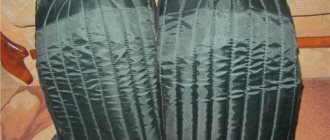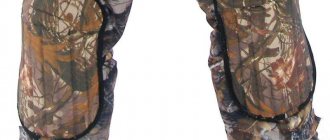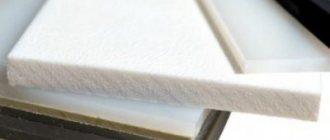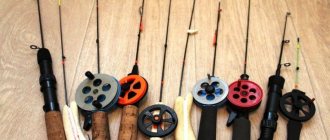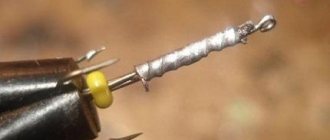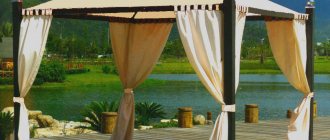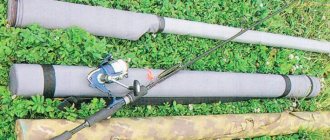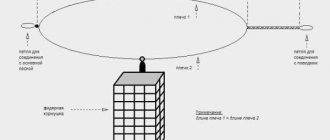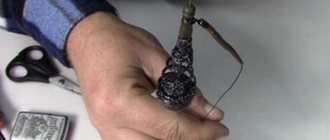How to sew knee pads with your own hands. How to make knee pads
Knee pads are a useful thing that can be useful to everyone: motorcyclists, skateboarders, roller skaters, football players and even the most ordinary summer residents.
Everything is clear about professional athletes: they always use branded knee pads from the best manufacturers. But what about amateur boys whose pocket money is tight, or summer residents who don’t need to buy “cool” products for weeding their garden? There is a cheap and easy solution: knee pads made from... plastic bottles! You will need
- Plastic bottles; glue "Moment"; soft cloth; awl; large pin or large tailor's pin; wide elastic bands.
Instructions
1
The advantages of this method are obvious: there is no need to spend a lot of money on buying “real” knee pads, there is no need to invent extravagant ways of sewing these necessary parts from leather, leatherette and stuffing this “skin” with some kind of rubbish “for softness”. And, in addition, plastic knee pads are an almost weightless thing that takes up very little space, so you can take it with you anywhere.
2
Cut a rectangle from the bottle - a shield to protect the knee joints. You can make it larger or smaller, depending on your personal comfort and, of course, physical parameters. The optimal dimensions are 15 centimeters up and 15 centimeters down, if you count from the kneecap itself. Thanks to this “pattern”, the knee pad will not interfere with the work of muscles and joints, will not restrict movements and will not painfully cut into the skin.
3
Carefully place a soft cloth on the inside of the plastic shields. To prevent it from “driving” inside and constantly flying out, it is better to glue it to the plastic with glue.
4
Holes are made on the sides of each plastic part with an awl or a large pin - two for each shield.
5
Insert elastic bands into the holes that will hold the knee pads on your legs. It is better to insert large elastic bands: then they can be easily adjusted to the size of your feet and tied.
Various models
Knee pads for babies can be made from a variety of materials:
- made of dense fabric that protect the child from wounds. They are very easy to care for, since any dirt can be easily washed off, and small holes can be sewn up. Available in different colors, which makes it possible to choose knee pads to suit any style and color of clothing;
- knee pads with inserts. Mainly intended for children under one year old. Made from fabric with silicone or latex stripes on the front side. This protection protects the baby’s skin and joints;
- plastic. They differ from other models in the plastic covering on the front side of the knee pad. Designed to protect the knees when walking, but it is not convenient for a baby to crawl in them. In this case, we recommend removing the top stripe.
Knee pads with inserts
The model of knee pads should be chosen depending on the age of the baby. If the baby is just starting to crawl, then fabric ones are best suited for him, since they will not hinder the movement of the knee. For older children - plastic ones.
How should I wear it?
In summer, we recommend putting knee pads directly on the baby’s bare legs to avoid heat rash under the knees. And in winter it should be worn over clothing. It is not only convenient, but also practical. Thanks to the knee pads, you can avoid rubbing or getting your pants wet in the knee area.
How to sew knee pads for the garden. How to make knee pads with your own hands for the garden, photos and videos
Knee pads are a very useful and popular item. This accessory is used by athletes, builders and dancers. Knee pads can also be very useful for gardeners. And although they are all very similar to each other, they still have some differences.
For example, knee pads for athletes are designed to protect the knee joint from bruises and scratches, dancers need reliable support, and summer residents need softness and warmth. Therefore, it will be very difficult to buy a suitable model, especially since you can make them yourself much faster and cheaper. Such an accessory will meet all the requirements and will definitely fit the owner.
Knee pads for the dacha and garden are designed to make work in the garden beds easier - weeding, sowing seeds, loosening. Since such work requires standing all the time, bending over or squatting. Such positions are very uncomfortable, and are often contraindicated for older people. Knee pads for the garden must meet the following requirements:
- be soft so that the pebbles on the ground do not cause inconvenience;
- waterproof, since you often have to work on wet soil;
- match the size of the knee joint;
- warm to prevent hypothermia of the knee joints during spring sowing, as this entails inflammation and swelling.
How to make your own knee pads for the garden
Knee pads for working in the garden can be made from various materials. There are many options for disposable and reusable knee pads. Making disposable devices with your own hands takes only 5-10 minutes.
You can use pieces of foam simply by tying them to your knees. But this option is not the most convenient, since this accessory will be needed every day, and polystyrene foam is a very brittle material.
Therefore, it is much better to sew good reusable knee pads with your own hands. It's quite simple, the main thing is to follow the recommendations exactly.
- Materials for production. To sew warm and comfortable knee pads you will need: water-repellent fabric, Velcro, wide elastic, some pipe insulation and, if desired, foil insulation.
- First you need to take measurements of the knee to cut the materials to size. For example, let's take a width of 20 cm and a length of 35 cm. These parameters are suitable for people of average height.
- You need to cut 2 blanks from a piece of insulation, first multiplying the size by 3. That is, the size of each blank will be 60 cm by 105 cm. Then the insulation needs to be folded in three. Three layers will provide reliable thermal insulation of the joint and protect it from the penetration of cold. If desired, you can add another layer of insulation, then the original size is multiplied by 4.
- Sewing a cover. Then, according to the dimensions, you need to sew a rectangular cover, adding 1.5–2 cm to the pattern on each side. You need to insert the insulation into the finished case and straighten it there. To prevent it from crumpling and getting lost, you can sew it along the edges manually along with the cover.
- Installation of fasteners. It is convenient to use Velcro tape as fastenings. The tape should be wide enough, Velcro is sewn to it, and then everything is sewn together with the knee pad. In order for the knee pad to fit well on the leg, it is best to use two fasteners that are sewn at the top and bottom of the knee pad.
With your own hands
As you know, children are big fidgets, they constantly run and jump, and their knees are often injured. Injury can occur both at home and on the street, in the country. The desire to solve this problem prompts the idea of sewing knee pads with your own hands. As it turned out, knee pads are not difficult to make, and they can be used by completely different people: from protecting very young children to protecting adults. With this accessory you can engage in completely different activities: sports and rhythmic gymnastics, play football and even work in the summer garden or repair something at home. In each individual case, materials and product design are selected individually.
The design can be completely different, from the hemmed upper part of socks for the smallest athletes to knee pads for gymnastics with leather protection or for working in the garden with plastic protection.
Such knee pads will protect a child from knocking down their knees, protect an adult in the garden from dust and dirt, and protect an athlete during exercise.
Let's figure out how to sew knee pads for gymnastics with your own hands.
Knee pads for gymnastics can be sewn at home with such high quality that they will turn out no worse than those sold in stores. To do this, you need to prepare the following materials: thick fabric, artificial leather used for finishing doors or furniture, fleece fabric for softness, elastic band at least 25 millimeters wide.
It is necessary to take three measurements: the circumference of the leg above and below the knee and the height of the cuff. The accuracy of taking measurements is important to ensure that the products fit tightly, do not fall off and do not compress the knee joint when bending. Using these measurements, a pattern is made 5 centimeters larger than the height of the cuff. This is necessary for hemming 2.5 cm wide elastic at the top and bottom.
To ensure the strength of the knee pad, leather parts measuring approximately 12 by 9 cm are cut out. You can be creative in the shape of the leather parts: they can be any round, square, triangular or heart-shaped, functionality will not suffer from this.
First, the bottom is folded to the width of the elastic, it is inserted behind the hem and stitched with a knitted seam, then fleece and leather patches are sewn on the front side along the perimeter, the upper elastic is attached in the same way, and then a vertical seam is made. To do this, the fabric is joined with an overlap or using an internal seam.
DIY tactical knee pads. How to make your own knee pads for the garden
Knee pads for working in the garden can be made from various materials. There are many options for disposable and reusable knee pads. Making disposable devices with your own hands takes only 5-10 minutes.
You can use pieces of foam simply by tying them to your knees. But this option is not the most convenient, since this accessory will be needed every day, and polystyrene foam is a very brittle material.
Therefore, it is much better to sew good reusable knee pads with your own hands. It's quite simple, the main thing is to follow the recommendations exactly.
- Materials for production. To sew warm and comfortable knee pads you will need: water-repellent fabric, Velcro, wide elastic, some pipe insulation and, if desired, foil insulation.
- First you need to take measurements of the knee to cut the materials to size. For example, let's take a width of 20 cm and a length of 35 cm. These parameters are suitable for people of average height.
- You need to cut 2 blanks from a piece of insulation, first multiplying the size by 3. That is, the size of each blank will be 60 cm by 105 cm. Then the insulation needs to be folded in three. Three layers will provide reliable thermal insulation of the joint and protect it from the penetration of cold. If desired, you can add another layer of insulation, then the original size is multiplied by 4.
- Sewing a cover. Then, according to the dimensions, you need to sew a rectangular cover, adding 1.5–2 cm to the pattern on each side. You need to insert the insulation into the finished case and straighten it there. To prevent it from crumpling and getting lost, you can sew it along the edges manually along with the cover.
- Installation of fasteners. It is convenient to use Velcro tape as fastenings. The tape should be wide enough, Velcro is sewn to it, and then everything is sewn together with the knee pad. In order for the knee pad to fit well on the leg, it is best to use two fasteners that are sewn at the top and bottom of the knee pad.
Do-it-yourself warm knee pads. How to knit knee pads from wool with knitting needles?
Knee pads made of wool are a very useful find for any craftsman. Their role is not so much aesthetic as therapeutic. It is the treatment and prevention that are performed by ordinary knitted wool knee pads. So that they do not interfere with movement, but also do not fall off or put pressure. Let's look at a model of knee pads that even a beginner can easily perform.
There are no barriers at all regarding the color of the yarn and you can use any range to create them, the color you like. But the yarn itself must be warm and it is only wool. The most natural fiber will always be better than any acrylic and other impurities.
You can also use prickly options, as they contain more wool, which will affect the joints. The knitting needles must be the same number as indicated for the yarn. Since the loops should be tight to each other.
Step-by-step instructions on how to knit wool knee pads
Very convenient instructions for creating knee pads with knitting needles are divided into stages. It's simply impossible to make a mistake.
Taking measurements
Using a measuring tape, we measured the joint and wrote it down on a piece of paper so as not to repeat the measurement several times.
Set of first stitches for 2 knitting needles
Sample
We knitted a small sample using an elastic band with 1*2 knitting needles. That is, a square for calculating loops and rows of 10 cm. Two numbers were also written down on a piece of paper - this is the knitting density.
Loop calculation
Next, for the circumference of the joint, we determined by density how many loops would be required for circular knitting.
Elastic knee pad
The knee pad is knitted from the bottom of the product. It all starts with a 1*2 elastic band. Knitting according to the pattern.
Elastic pattern 1*2:
Row 1: k/p, p2/p, (repeat k/p and p2/p). Next, the top row (circle) by analogy and the front one above the front one, 2 purl ones, respectively, over two purl ones.
Knit 10 rows of this elastic band and switch to a circle for the knee pad. For it, you first need to replace 6 elastic loops with the purl stitch. Knit two rows with an insert from the purl stitch. Work the next two rows in stockinette stitch and additionally grab a stitch on each side of the elastic. Repeat increasing and alternating knit two rows and purl rows until 9 purl stripes are formed.
Facial surface
Next, knit by analogy, only instead of increasing, you need to make decreases. Continue until you have a strip of 6 stitches. Switch knitting to an elastic band again and use this elastic band to do 10-20 cm. This is at the discretion of the master.
This is how you can easily and simply knit a useful product for your joints. Or make a wonderful gift for an elderly person who knows what joint pain is.
Maybe just such a knee brace will be useful.
Knitting warm things is very simple, but creating something with a healing effect is simply skill. We are trying to create not only knee pads, but also other insulating and simply beautiful things.
How to choose the right knee pads for gymnastics
Children's knee pads for rhythmic gymnastics should, first of all, be elastic, not restrict movement, stretch easily, and protect the knees from injury. The elastic material from which the knee pads are made can be of different colors: from flesh-colored to bright green.
Girl wearing knee pads for gymnastics
- made of cotton, which gives softness and comfort;
- made of leather that can breathe freely. Unfortunately, they don't last long;
- Lycra knee pads are elastic and perfectly breathable;
- Neoprene knee pads have compression and warming properties;
- strong and durable made of nylon;
- Spandex knee pads provide the most secure knee support.
Initially, you should consult with an orthopedist regarding the choice of a model of gymnastics knee pads.
Before purchasing, be sure to try them on and make sure that your baby is comfortable in them.
If there are latches, you should check their functionality to ensure that they hold well and do not come loose.
During exercises, the leg should be well fixed, but at the same time mobile.
What can replace knee pads with? Knee pads for arthrosis of the knee joint. How to choose
Almost always, along with traditional methods of treatment, the doctor prescribes the wearing of orthopedic devices.
The type depends on the degree of arthrosis, age and purpose. These products are used both for everyday wear and for use during periods of maximum stress on the legs (sports, long walking).
Knee pads have different sizes, different rigidity of fixation of the knee joints.
You should choose them very carefully, since an incorrectly selected knee pad will be, at a minimum, useless and, at a maximum, cause harm.
These orthopedic products are also used for bruises, sprains, dislocations, damage to the meniscus and for the prevention of arthrosis (they should be worn if you know that you will have physical activity).
Their use has almost no contraindications.
What is a knee brace for?
The knee brace creates favorable conditions for the functioning of the knee joint and prevents the joint from “dangling”.
The knee joints experience the greatest load when walking, and these orthopedic products are very good at reducing and evenly distributing this load throughout the joint, thereby relieving pain and giving confidence in movement.
With constant wearing, blood circulation improves, and hence nutrition of the cartilage.
Swelling and inflammation are reduced. Pain caused by arthrosis is significantly reduced.
